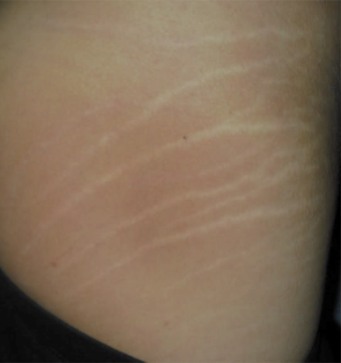Stretch marks on men are less common than stretch marks on women, but men can get them, too. The pink, red, or purplish indented marks usually occur as a result of overstretched skin and while they generally fade in time, appearing silvery or flesh-toned in color, they often never disappear completely. We’ll tell you about the possible causes of stretch marks in men (did you know lifting weights can sometimes cause them?) and how they can be treated.
What Causes Stretch Marks on Men?

Men can get stretch marks for all the same reasons women get them, with the exception of pregnancy, of course. Causes of stretch marks include:
- Weight gain, especially large amounts of weight and rapidly gained weight.
- Lifting weights (often leads to the development of stretch marks on the upper arms, more common in men than in women).
- Rapid growth spurts in adolescent males.
- Use of corticosteroid medications, especially over a long period of time.
- Certain illnesses, such as Cushing’s disease and disorders of the adrenal gland.
- Genetic factors may also play a role in the likelihood of individual developing stretch marks.
It’s difficult to prevent stretch marks, often impossible. However, maintaining a healthy body weight can definitely help. Excessive weight gain is probably the most common cause of stretch marks in men, and excessive weight gain can usually be prevented with a healthy diet and regular exercise.

How Are Stretch Marks in Men Treated?
The available treatments for stretch marks on men are the same as the treatment options for women with stretch marks. The best treatment for you will depend on a number of factors, including where your stretch marks are located on your body, how long the stretch marks have been there, and your overall health. Talk to your physician, a dermatologist, or a plastic surgeon about the best treatment option for you.
Treatment for stretch marks is usually considered cosmetic and not medically necessary, so health insurance policies usually don’t cover it. While the marks may be unsightly, they aren’t harmful and treatment isn’t required. Check with your insurance company if you have questions about your coverage. Some treatment options are pretty expensive, so you’ll want to keep that in mind when considering your options.
Treatment options for removing stretch marks include:
- Over-the-counter ointments and creams, some of which work and many of which aren’t very effective.
- Tretinoin cream, which contains a form of vitamin A, is most often used on recent stretch marks that are still red in color. It increases the production of collagen, which heals the damaged skin.
- Microdermabrasion, a minor surgical procedure in which the top layer of skin is sanded off, removing stretch marks and other imperfections and exposing healthier, unmarked skin beneath.
- Laser surgery, in which lasers are used to increase collagen, elastin, and/or melanin in the skin, making stretch marks less noticeable. Different types of lasers affect the skin differently and the type used on a particular individual depends on the location, age, and appearance of the stretch marks being treated.
It’s important to understand that while treatment can reduce the appearance of stretch marks and make them less noticeable, it often does not eliminate them completely.
Our Preferred Treatment For Stretch Marks on Men
Our preferred treatment for men with stretch marks is Insta Natural Stretch Mark and Scar Cream. It’s available over the counter for use at home and it’s affordable. Natural ingredients like vitamin C boost the production of collagen in the skin, while other natural ingredients like rosehip oil and grapeseed oil nourish and hydrate the skin and reduce the appearance of fine lines and other marks. To learn more about our favorite treatment for stretch marks, just follow the link.
WebMD – Stretch Marks
